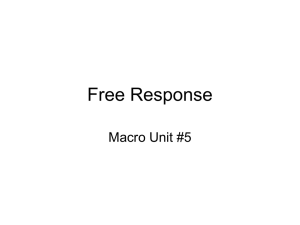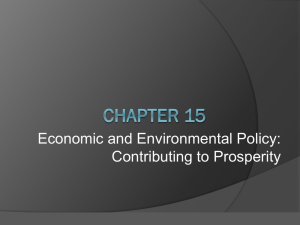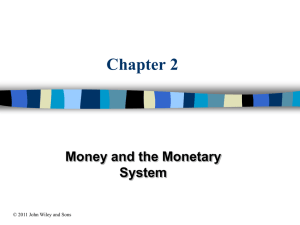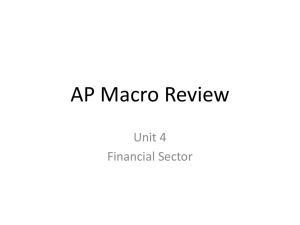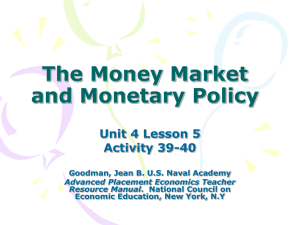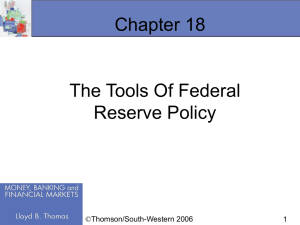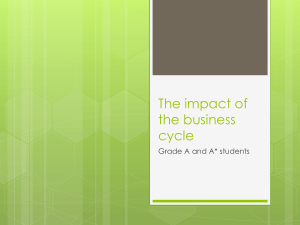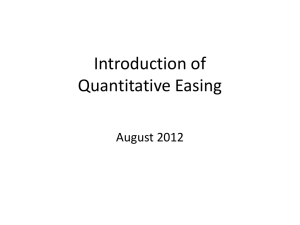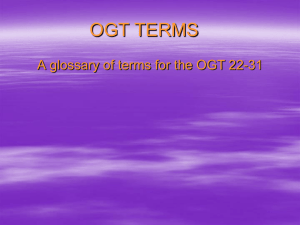Fiscal Policy issues
advertisement
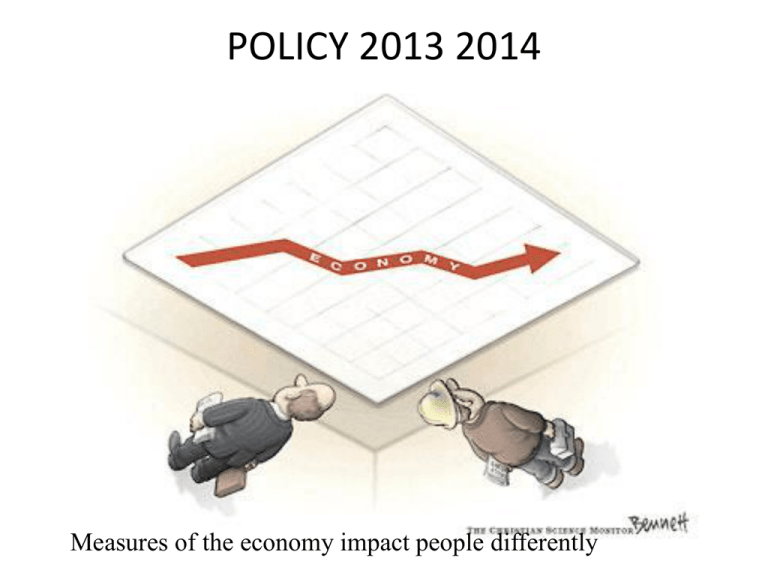
POLICY 2013 2014 Measures of the economy impact people differently We have a ________ System A form of economic order characterized by private ownership of the means of production and the freedom of private owners to use, buy and sell their property or services on the market at voluntarily agreed prices and terms However, that does NOT mean the government is not involved Two tools: Monetary vs Fiscal Policy ____________________A macroeconomic policy tool used by the government to regulate the total level of economic activity within a nation. Examples include setting the level of government expenditures and the level of taxation. vs . . . __________ tries to control the size of the total supply of money (and other highly liquid financial assets that are close substitutes for money) available in the national economy in order to: control inflation, and/or speed up/slow economic growth, and/or manage the level of unemployment and/ or influence the exchange rates at which the national currency trades for other foreign currencies Listen to Bernanke explain http://www.federalreserve.gov/faqs/money_12855.htm Fiscal Policy vs. Monetary Policy Attributes ________ Policy __________Policy the use of government expenditure and revenue collection to influence the economy the process by which the monetary authority of a country controls the supply of money, often targeting a rate of interest to attain a set of objectives oriented towards the growth and stability of the economy. Manipulating the supply of money to influence outcomes like economic growth, inflation, exchange rates with other currencies and unemployment. Policy-maker Manipulating the level of aggregate demand in the economy to achieve economic objectives of price stability, full employment, and economic growth. Government (e.g. U.S. Congress, Treasury Secretary) Policy Tools Taxes; amount of government spending, borrowing Interest rates; reserve requirements; currency peg; discount window; quantitative easing; open market operations; signaling Definition Principle Central Bank (e.g. U.S. Federal Reserve) Watch: http://www.youtube.com/watch?v=TvzsjOmWgKI VS . . . ____________ ____________________ done primarily by the Board of Governors of the federal reserve system : an I______________ R_________________ A_______________ It is made up of seven members who are appointed by the ___________ and confirmed by the _____________. The full term of a Board member is 14 years, and the appointments are s___________so that one term expires on each even-numbered year. The Chairman and Vice Chairman lead the Board. They are also appointed by the _____________and confirmed by the ___________. The nominees to these posts must already be members of the Board or must be simultaneously appointed to the Board. The terms for these positions are four years, but the Chairman and Vice Chairman may be reappointed for additional four-year terms, as long as their term as Board member is active . Here they are: http://www.federalreserve.gov/aboutthefed/default.htm The Fed is an __________________ _______________________ ___________________________________ Watch Yellen Confirmation hearing before _________________ Banking committee (ahem, a standing committee) http://www.youtube.com/watch?v=8u5Wm6GNeaA Dual Mandate: When the U.S. Congress amended the Federal Reserve Act in 1977, it essentially gave the Fed a dual mandate: to promote maximum sustainable employment and price stability. Price stability is usually interpreted as low and stable inflation . . . . What Yellen Means For Student Loans, Mortgages And The Economy http://www.npr.org/blogs/money/2013/10/09/230693851/what-janet-yellenmeans-for-student-loans-mortgage-rates-and-the-rest-of-the-eco The Key To Power At The Federal Reserve? Running The Meetings http://www.npr.org/blogs/money/2013/09/23/225487972/the-key-to-powerat-the-federal-reserve-running-the-meetings 3 Things the FRB does to manipulate the _________ of money (1) It can set discount _______for money that banks borrow from the Fed. Reserve banks--if rate down, more people can borrow, more money available in economy but concern is ___________. If rate up, inflation may be ok but risk a ___________ cuz it is hard to borrow (2) it can increase or decrease the _______requirements that banks must keep--if lower, more money in economy, (also brings down interest rates) but concern is _____________, if higher money is tied up but risk _________ (3) it can buy and sell govt._________ (bonds, treasury notes and other government IOUs which are savings devises) ib the open market, When the govt. buys, it puts more money in circulation, and takes securities out of circulation, With more money around, interest rates tend to drop, so more private money is borrowed and spent. But concern is _______If the Fed sells securities, it takes money out of circulation, (it is going into savings) causing interest rates to rise by See “See What is Quantitative Easing BBC (Visual) http://www.bbc.co.uk/news/business-15198789 making borrowing harder Open Market Operations The Fed’s most frequently used monetary policy tool is open market operations. This consists of buying and selling U.S. government securities on the open market with the aim of aligning the federal funds rate with a publically announced target set by the FOMC. The Federal Reserve Bank of New York conducts the Fed’s open market operations through its trading desk. If the FOMC lowers its target for the federal funds rate, then the trading desk in New York will buy securities on the open market. The Fed pays for these securities by crediting the reserve accounts of the banks that sell the securities. In essence, when the Fed buys securities through open market operations, it is creating money. Additional money in these bank reserve accounts puts downward pressure on the federal funds rate according to the basic principle of supply and demand. In turn, short-term market interest rates directly or indirectly linked to the federal funds rate also tend to fall. Lower interest rates encourage consumer and business spending, thereby stimulating economic activity. On the other hand, if the FOMC raises its target for the federal funds rate, then the New York trading desk will sell government securities, collecting payments from banks by withdrawing money from their reserve accounts. Less money in these reserve accounts means a smaller supply of money in the banking system, putting upward pressure on the federal funds rate. That typically causes market interest rates to rise, which damps consumer and business spending, slowing economic activity and reducing inflationary pressure. Best explanation: http://www.frbsf.org/education/teacher-resources/what-is-thefed/monetary-policy _____Policy the use of government expenditure and revenue collection to influence the economy Fiscal Policy issues The Keynes vs. Hayek Debate John Maynard Keynes and Friedrich Hayek were two famous economists with differing opinions on how to address the boom bust cycle that leads to budget deficits. In fact, the debates between these two economists were somewhat famous for being rather boisterous and unruly. Keynes argued that governments should intervene to help put jobless back to work by implementing economic stimulus and other programs. If these people were employed, GDP growth would accelerate and debt as a percentage of GDP would be reduced. The prospects of a long-term growth rate would also making financing current projects much easier. Hayek insisted that these programs would simply delay a day of reckoning. Instead, the economist argued that governments should instead reduce spending and taxes in order to make room for the free markets to determine the right course of action. While this could mean a deleveraging in the short-term, it would equate to a far healthier long-term economy. See Keynes v Hayak on the impact of gov’t spending on the economy http://www.youtube.com/watch?v=GTQnarzmTOc Examples The Economic Stimulus Act of 2008 (Pub.L. 110-185, 122 Stat. 613, enacted February 13, 2008) was an Act of Congress providing for several kinds of economic stimuli intended to boost the United States economy in 2008 and to avert a recession, or ameliorate economic conditions. The stimulus package was passed by the U.S. House of Representatives on January 29, 2008, and in a slightly different version by the U.S. Senate on February 7, 2008. The Senate version was then approved in the House the same day.[1] It was signed into law on February 13, 2008 by President Bush with the support of both Democratic and Republican lawmakers The 2009 American Recovery and Reinvestment Act, (aka the “________Package”) was designed to help the economy recover from the 2008 financial crisis and subsequent r__________. Unlike TARP, which helped big business, ARRA was specifically designed to put more money into the pockets of American families and small businesses. The goal was to stimulate d__________ by redirecting $260 billion in federal funding through tax cuts, tax credits and unemployment benefits. • Cut taxes by $400 for individuals and $800 for families through reduction of withholding. This caused confusion, since many people expected checks like the Bush Tax Cuts. • A payment of an additional $250 each to recipients of Social Security, veterans pension and Supplemental Security Income (SSI) benefits. • $70 billion to extend the AMT tax shelter. (This is usually extended each year by Congress, anyway.) • Greater access to the child tax credit for the working poor and an expanded earned________ tax ______ to families with three children. • A $2,500 college tuition tax credit for 2009 and 2010. • An $8,000 tax credit for first-time homebuyers in 2009 only. (This was later extended through April 2010.) Deduction of sales tax on new car purchases through 2009 only. • Unemployment benefits were extended for another 33 weeks. • Suspension of taxes on the first $2,400 of unemployment benefits through 2009 http://roomfordebate.blogs.nytimes.com/2009 /11/01/did-the-stimulus-work/ House Passes Stimulus Plan With No G.O.P. Votes House Speaker Nancy Pelosi and Majority Leader Steny Hoyer at a news conference on the economic stimulus package January 28, 2009 WASHINGTON — Without a single Republican vote, President Obama won House approval on Wednesday for an $819 billion economic recovery plan as Congressional Democrats sought to temper their own differences over the enormous package of tax cuts and spending. . . . All but 11 Democrats voted for the plan, and 177 Republicans voted against it. The 244-to-188 vote came a day after Mr. Obama traveled to Capitol Hill to seek Republican backing, if not for the package then on other issues to come Oooh ahh review: _________ship . . . This is a __________vote Flexible Cohesive Wrap Bandage More . . . . .Fiscal Policy issues Debt Ceiling / Debt Limit: When the revenues collected by the federal government are not sufficient to cover its expenditures, it must finance the shortfall through borrowing. In addition, the federal government is compelled to incur debt because of requirements that trust fund surpluses be invested in federal securities. Federal borrowing is subject to a public-debt limit established by statute: public debt is subject to a statutory limit, 31 U.S.C. 3101. As long as the federal government incurs annual deficits and trust funds incur annual surpluses, the public-debt limit must be increased periodically. The frequency of congressional action to raise the debt limit has ranged in the past from several times in one year to once in several years. Watch: CPJ Grey: Debt Limit http://www.youtube.com/watch?v=KIbkoop4AYE Capitol Leaders Agree to a Deal on the Budget Patty Murray: Democrats' Unlikely Iron Lady Of The Budget Battle http://video.foxnews.com/v/2921041966001/t wo-year-budget-deal-announced-to-avoidgovt-shut-down/?playlist_id=928378949001 three ways to address federal deficits: •Spending - Countries can increase spending in hopes of spurring growth rates. The higher growth rates increase GDP and reduce debt as a percentage of GDP and make it more manageable. •Austerity - Austerity measures involve cutting government spending. These cuts can produce immediate reductions in future debt, which means debt as a percentage of GDP will decline, if GDP remains stable. •Taxes - Raising taxes can help shore up government finances, but they put strain on taxpayers and corporations operating within the country. Conversely, lowering taxes can be a way to spur growth by encouraging private spending and investment. ________policy is typically implemented by a central bank, while _________ policy decisions are set by the national government __________ Policy: The stance taken by government with regard to its spending or taxation with a view to influencing the level of economic activity. ________ Policy The use by government of changes in the supply of money and interest rates to achieve desired economic policy objectives. They aim therefore to influence the level of economic activity. The government may want to use this kind of policy to either boost economic activity (if the economy is in a recession) or perhaps to reduce economic activity (if the economy is growing too fast, causing inflation) _______ _________The actions of a central bank, currency board or other regulatory committee that determine the size and rate of growth of the money supply, which in turn affects interest rates. This kind of policy is maintained through actions such as increasing the interest rate, or changing the amount of money banks need to keep in the vault (bank reserves). _______ Policy The federal government’s decisions about the amount of money it spends and collects in taxes to achieve full employment and a noninflationary economy. Why one over the other? Most politicians prefer ____________ to ____________policy. • it shifts responsibility from them to the _______--an independent board of bankers and economists. During periods of _______, this can be particularly attractive since the goal is to ____________money from circulation, the fiscal policy response of increasing ______and/or cutting government _______ is not very popular with voters. • In addition, some argue that business leaders and consumers are better equipped to manage the money that is injected into the economy during period of recession. Even though a government institution—the _____—makes the decision to ______ interest rates, private borrowers (businesses and consumers) actually decide where and how to spend that money. Ok do you get it? Each policy has a name(s)/position associated with its execution. What are they? One is in the cabinet, the other heads an independent agency—which One could be fired by pres, one could not: which? Which one could congress fire? Which has to be appt by pres, approved by Senate? What are the 3 tools of Monetary Policy? Assume the fed wants to boost economic productivity—would it increase supply or decrease? For each tool, how would it do that? Ok do you get it? Each policy has a name(s)/position associated with its execution. What are they? One is in the cabinet, the other heads an independent agency—which One could be fired by pres, one could not: which? Which one could congress fire? Which has to be appt by pres, approved by Senate? What are the 3 tools of Monetary Policy? Assume the fed wants to boost economic productivity—would it increase supply or decrease? For each tool, how would it do that? ‘”Quantitative Easing” A government ________policy used to ________the money supply by _______government securities or other securities from the market. Quantitative easing increases the money supply by flooding financial institutions with capital, in an effort to promote increased lending and liquidity and by decreasing the value of investments such as bonds so that they are _______ attractive and investors will invest elsewhere.. ________banks tend to use quantitative easing when _______ ______have already been lowered to near 0% levels and have failed to produce the desired effect. The major risk of quantitative easing is that, although more money is floating around, there is still a fixed amount of goods for sale. This will eventually lead to higher prices or inflation. It also hurts people who have or are about to _______________ because they need a safe place to invest The revenue side graduated tax - any tax in which the rate increases as the amount subject to taxation increases Income Taxes If you work in the United States, you will probably incur some sort of federal income tax liability each year. Most people will also owe state income taxes, A few cities and townships add another layer to the mix of taxes you’ll pay; this list details what the various state and local governments charge. The amount you owe — for federal, state and local taxes — is determined by how much you earn each year. The United States uses a progressive tax system, which means the more money you earn, the higher your tax rate. The chart above lays out the different tax brackets and rates, which depends on your filing status (single, married couples filing jointly, married filing separately, etc.). Historical federal marginal tax rates for income for the lowest and highest income earners in the US Among OECD countries only Mexico, Turkey, Korea, and Japan had lower taxes than the United States as a percentage of GDP. In many European countries taxes exceeded 40 percent of GDP, but those countries generally provide much more extensive government services to their citizens than the United States does. The United States relies less on consumption taxes—17 percent of total 2006 tax receipts—than any other OECD country. Revenue from such taxes averaged 32 percent of total taxes among the 30 OECD countries. Mexico, in contrast, collected 56 percent of its 2006 tax revenue from consumption taxes. Health care law Provisions Explained: Kaisar Foundation http://www.youtube.com/watch?v=JZkk6ueZtU Supreme Court Opinion explained http://www.youtube.com/watch?ann otation_id=annotation_417818&featu re=iv&src_vid=04n6qrBwFBE&v=egXu rxdD7kE Obamacare explained Fox talk radio: http://video.foxnews.com/v/2698443378001/ obamacare-explained/ Subsidy: Monetary assistance granted by a government to a person or group in support of an enterprise regarded as being in the public interest. Farm Bill Why $7-Per-Gallon Milk Looms Once Again http://www.npr.org/player/v2/mediaPlayer.html?action= 1&t=1&islist=false&id=248648797&m=248718289 Price supports Congress Poised To Make Crop Insurance Subsidies More Generous http://www.npr.org/blogs/thesalt/2013/05/30/18734672 6/Congress-Poised-To-Make-Crop-Insurance-SubsidiesMore-Generous Farm Bill Conference Committee: http://www.youtube.com/watch?v=ty2grhWsQNg Still no resoultion Dec 12: http://www.nytimes.com/2013/12/12/us/politics/no-farm-bill-in-sightas-recess-looms-for-congress.html?ref=us&_r=0 Regulations impact the economy • http://naturalresources.house.gov/news/docu mentsingle.aspx?DocumentID=234157 • Romney and Obama debate regulations: http://www.youtube.com/watch?v=00AuDlN3 xpU See ted talk: http://www.youtube.com/watch?v=QPKKQnijnsM Definition: The Gini index measures the extent to which the distribution of income (or, in some cases, consumption expenditure) among individuals or households within an economy deviates from a perfectly equal distribution. A Gini index of zero represents perfect equality and 100, perfect inequality index ranged from 0.21 to 0.65 in 2010 across the United States, according to Census Bureau estimates.[27] Income Gini coefficient United States, 1947–2011 Year Comments 1947 0.413 (estimated) 1967 0.397 (first year reported) 1968 0.386 1970 0.394 1980 0.403 1990 0.428 2000 0.462 2005 0.469 2006 0.470 2007 0.463 2008 0.467 2009 0.468 2010 0.469 2011 0.477 Trend since the 1980s is market _______________ Double Take 'Toons: The Popeulist? December 01, 2013 5:23 AM Pope Francis recently issued an 84-page paper criticizing the excesses of capitalism, stating "it is evident that unbridled consumerism combined with inequality proves doubly damaging to the social fabric." Mike Luckovich doubts some will hear him, while Rainer Hachfeld believes the Holy Father has joined the company of Karl Marx and Friedrich Engels. The Car Allowance Rebate System (CARS), colloquially known as "cash for clunkers", was a $3 billion U.S. federal scrappage program intended to provide economic incentives to U.S. residents to purchase a new, more fuel-efficient vehicle when trading in a less fuel-efficient vehicle. The program was promoted as providing stimulus to the economy by boosting auto sales, while putting safer, cleaner and more fuel-efficient vehicles on the roadways Definition of 'Government Security government debt obligation (local or national) backed by the credit and taxing power of a country with very little risk of default Treasury bills (T-Bills), notes and bonds are marketable securities the U.S. government sells in order to pay off maturing debt and to raise the cash needed to run the federal government . When you buy one of these securities, you are lending your money to the government of the United States. T-bills are short-term obligations issued with a term of one year or less, and because they are sold at a discount from face value, they do not pay interest before maturity. The interest is the difference between the purchase price and the price paid either at maturity (face value) or the price of the bill if sold prior to maturity Treasury notes and bonds, on the other hand, are securities that have a stated interest rate that is paid semi-annually until maturity. What makes notes and bonds different are the terms to maturity. Notes are issued in two-, three-, five- and 10-year terms. Conversely, bonds are long-term investments with terms of more than 10 years. The yield on a bond is determined at auction. Bonds are sold in increments of $100. The minimum purchase is $100. You can hold a Treasury bond until it matures or sell it before it matures. In a single auction, an investor can buy up to $5 million in bonds by non-competitive bidding or up to 35% of the initial offering amount by competitive bidding. http://www.cnbc.com/id/43314518 treasury bond price explained My Father's friend got a 500,000,000 federal reserve bond series of 1934? It was like a whole bond paper with a dollar amounting $500,000,000 and there are lots of small stab at the side (federal reserve notes) as payments for all debts and expenses series in 1934. they hunt it 3 weeks ago in a cave here in Phils. It was in a metal box with i think 10x12 inches size, total of 250pcs. including certificates and 3 gold coins at the top. We are just curious where to ask about it, does it has a value if ever, and where to surrender the said treasure. Is any protections given to the one who hunts it? Pls. advise. thank you... Best Answer - Chosen by Voters What you have there is a lovely box full of fakes. First, the US never issued any kind of bonds in that high a denomination. Second, a real bond would be engraved and printed on the same cotton fiber substrate as US banknotes, and NEVER on watermarked bond paper. This scam has been going on in the Philippines for years. The back story is always a variation of the bonds were newly discovered from their WW2 hiding place, and they are always insanely high denominations. They are not real. Period.
